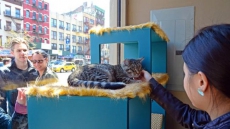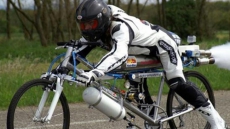EDMONTON — Evelyn Moore isn't the fastest kid on the racetrack, but she's by far the tiniest.
At 13-months old, the paralyzed toddler skilfully wheels her homemade wheelchair around the simulated track at Treehouse, an indoor playground in northeast Edmonton that she often visits with her mom.
Several school-age children whiz by on souped-up tricycles and she stops to stare and clap.
"She really gets around now," says Kim Moore, who first put her daughter in the makeshift chair — basically a purple, foam Bumbo seat on wheels — at seven months.
Just like other children learn how to crawl, Evelyn slowly figured out how to wheel.
"She went backwards first and then she went forwards, and then she figured out how to turn," Moore says. "And now we have a speed bump in the middle of our living room because she just goes that fast."
Evelyn — also called Eva by her family — was diagnosed with cancer following her four-month check up. A nurse noticed too much movement with the child's hips, then a doctor recognized a lump protruding from her spine.
The stage 4 neuroblastoma tumour couldn't be removed, so she underwent eight rounds of chemotherapy.
Although the cancer is in remission, Evelyn's family received more bad news: their first child is permanently paralyzed below her arms.
It was heart-breaking, says Moore.
"But then you go home and you cry and you come back the next day and be the strongest mom and dad you can ever be."
Moore says doctors told her that Evelyn would likely "army crawl," pulling herself around with her arms, until she was about two. Wheelchairs would come after that.
"I guess that wasn't a good enough answer for me," Moore says.

She wanted her daughter to have some independence like other children.
While searching on the social networking website Pinterest, she found photos of a do-it-yourself baby wheelchair and asked her husband, Brad, to build it. He spent a night in his garage attaching a second-hand Bumbo chair to a kitchen cutting board, then put casters on the bottom and small wheels from a children's bike on each side.
It took a while for Evelyn to figure it out. Then one day Dad nudged her down the driveway and she was able to stop herself.
She now waves her arms when she knows she's about to be put in her chair, and — able to only speak a few words like "dada" and "uh-oh" — tilts the chair back and forth, clicking the casters to show she's excited.
The chair cost about $100 to make. As Evelyn gets bigger, she'll move into other chairs that will cost thousands of dollars.
Her mother says they're preparing themselves for those bills.
Dr. Bev Wilson, a pediatric oncologist, says she was amazed when Evelyn first came into her office in the chair, bumping into staff to get their attention. The doctor had never seen a child so young in a wheelchair.
"She looked like any adult or older child would in a wheelchair," Wilson recalls. "She was turning around in circles, backing up."
The chair gives Evelyn freedom, she says.
"Normally, she would be propped in a chair or a seat or a stroller somewhere. This has allowed her to explore her environment just like a crawling child would."
Wilson adds that she would recommend a "rigged up" wheelchair like Evelyn's to parents of other paralyzed youngsters.
Brad Moore, away from home on a two-week work stretch at a diamond mine in the Northwest Territories, says over that phone that he's proud of his little girl.
"The willpower that she has, and how adaptable she is to her situation, is something I never really expected. And how quickly she's grasping it has really blown me away."
He wants her to grow up knowing that she can do anything, he says.
"Nothing can stop her."





